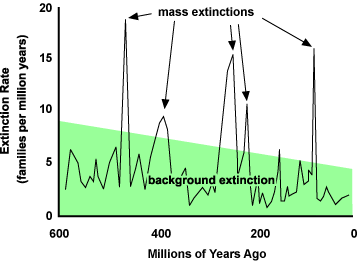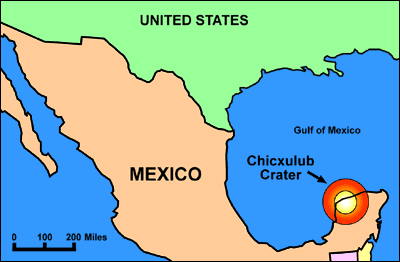 For any one species, extinction may seem catastrophic. But over the grand sweep of life on Earth, extinction is business as usual. Extinctions occur continually, generating a “turnover” of the species living on Earth. This normal process is called background extinction. Sometimes, however, extinction rates rise suddenly for a relatively short time — an event known as a mass extinction. Mass extinctions kill off many species, but the empty niches left behind may allow other lineages to radiate into new roles, shaping the diversification of life on Earth.
For any one species, extinction may seem catastrophic. But over the grand sweep of life on Earth, extinction is business as usual. Extinctions occur continually, generating a “turnover” of the species living on Earth. This normal process is called background extinction. Sometimes, however, extinction rates rise suddenly for a relatively short time — an event known as a mass extinction. Mass extinctions kill off many species, but the empty niches left behind may allow other lineages to radiate into new roles, shaping the diversification of life on Earth.
With the data available now, it appears that life on Earth has experienced several mass extinctions. The most devastating, perhaps, was the Permian mass extinction 225 million years ago. About 90% of the species living at the time went extinct, including most of the dominant land vertebrates at the time, the synapsids. Scientists are studying this event to figure out whether it was caused by climate change, volcanic eruptions, sea level change, continental movement, asteroid impacts, or several of these factors.
The K-T extinction
 The K-T extinction (Cretaceous-Tertiary extinction, 65 million years ago) is famous for killing off the dinosaurs (except birds, of course!), along with two-thirds of all species on Earth. However, small mammals, turtles, crocodiles, birds, redwood trees and many others survived.
The K-T extinction (Cretaceous-Tertiary extinction, 65 million years ago) is famous for killing off the dinosaurs (except birds, of course!), along with two-thirds of all species on Earth. However, small mammals, turtles, crocodiles, birds, redwood trees and many others survived.
There is very good evidence that a giant asteroid hit Earth at the same time as the K-T extinction. The smoking gun is the 100-mile wide crater it left behind off the coast of Mexico, along with disturbed geologic deposits (iridium and shocked quartz) consistent with an asteroid impact. The impact probably caused tidal waves, earthquakes, and clouds of dust so thick that they blotted out the sun for months. Such a disaster is certainly capable of causing a mass extinction. However, many lineages were on the wane, experiencing a lot of extinction, even before the asteroid hit. These pre-impact extinctions must have other causes.
Check out our tutorial on mass extinction, or read about how extinction factored into the history of evolutionary thought.
Learn more about mass extinctions in context:
Learn more about the K-T extinction and the process of science: Asteroids and dinosaurs: Unexpected twists and an unfinished story, a case study from the Understanding Science website.
Teach your students about extinction:
Find additional lessons, activities, videos, and articles that focus on extinction.
